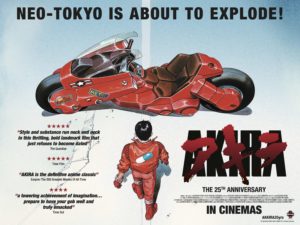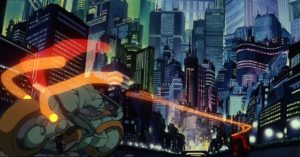 (5 / 5)
(5 / 5)
There is a name that is known to every manga and/or anime enthusiast worth their salt and that is Akira. The reason for this is probably (among its many other attributes) that it is a prime example of what Anime has to offer. Vast, elaborate backgrounds, a unique tale of science fiction, inspiring as well as grotesque images and characters that dwell into the depraved as well as the noble. American animation has primarily been for children or for the family, Disney would never attempt anything like this. We will never get anything this complex, this disturbing or well funded and executed.
https://youtu.be/7G5zQW4TinQ
As a country Japan knows the devastating impact of nuclear warfare. In the fifties it channeled that into the giant monster Godzilla which then birthed the entire Kaiju genre. Then Katsuhiro Otomo began a monster of a manga in 1982 and finished it in 1990, turning in a tale of almost five thousand pages of art. This movie came out in 1988. This is a streamlined telling of the tale that Otomo told but it is more about the visuals and the experiences that it offers than anything else.
The movie opens on a vast city-space that is Tokyo in 1988, then pans up to show an explosion, wiping out all. This triggers World War III. Then we cut to 2019 (so close now) and we are now in the new Neo-Tokyo, a city set to host the Olympics. Within this city are the bright, colorful lights of signs, and vehicle headlights, but they are contrasted by the blacks of the sky and the buildings themselves. And within this location motorcycle gangs race, beat and kill over nothing really. This is the city of Blade Runner, that is populated with the drug taking, violent youth of A Clockwork Orange sprinkled with a little doomsday mentality of the Mad Max movies. Whether these were a part of Otomo’s influence while crafting the story or not does not matter. All those stories hit on essential prophecies and fears that mankind will find itself in.
The leader of one of the gang’s is a boy named Kaneda, who sports a bright red jacket with a powered motorcycle to match. His best friend Tetsuo wants to ride his bike, but Kaneda says he cant handle it, so he gets on his and the other members ride off to beat on another gang. While they are doing this a riot is breaking out and there is a man who has been shot and is leading a boy though the street.
During the time of conception and release Japan was going through a major problem with it youth. They were indeed running wild and the economy was on the verge of collapse. Great pieces of art reflect the problems of the world at the time of their creation, b the themes are eternal, youths running amok, an unsteady economy and the dangerous places science can lead us are problems that will always come-up again and again.
The man who was shot then dies because of the riot and the child wanders off. His path then crosses with Kaneda and Tetsuo. Tetsuo crashes his bike right into him and gets injured, the boy is unaffected and we then see him clearly. Young in body but his skin is wrinkled.Suddenly military helicopters descend taking the wrinkled child and Tetsuo.
The image of seeing children but with old wrinkled skin is a striking one. Like much of the ins and outs of the movie it goes unexplained. We know it’s linked to their abilities but that’s as far as it goes. It could be viewed as the terrible hybrid of the generations. Youth that is burdened by the centuries of traditions and expectations. Or another interpretation is that the children have been given powers and with that comes responsibilities but they are unable to deal with it because of their age. Movies don’t necessarily have to give you all the information. They are the art of show don’t tell after all. Part of the fun and what makes people want to come back to re-watch a movie are the things that go-bye unsaid, if we got the full package on the first viewing then there would be no need to return. But a truly great movie has layers that you are able to peel back after repeated viewings.
Many details of the plot go by us without ever really getting fully explained. But this works because we see it from the position of the teenagers, who are equally bewildered and only marginally grasp the immense scope of their situation. Kaneda is not a truly well defined character, he is headstrong, enjoys simple (though very illegal) things, though if he were truly complete that would be a detriment to the movie. A world this vast, with so many themes and images doesn’t need the inclusion of even more layers. We just need someone who’s defined enough and that reacts to their situation with enough believe-ability that the audience can put themselves in their shoes. For simple stories we require deep characters, for crazy complex stories we need simple characters.
Traditionally in Japanese animation, the feature is animated and then the actors are brought in to put their voices over the animation. This movie was handled differently. It was done like Disney does theirs, wear the actors record first and then the animation is matched to their performance. Something that would probably go over the heads of regular viewers but for those with know this medium a little more they’ll see more shape and form to the lip-syncing.
Before this Otomo had only been an Anime director for two segments in two other feature films. He had done plenty of manga work and it seemed like that would be his medium to stay with. But when the opportunity to adapt his manga work into a fully fleshed-out movie he took it and with that changed the industry forever. He already came with such mastery of sound design, cinematography and movement of camera. True he was not alone in making the movie and was probably given some experts to help realize his vision. But this is technically his first movie and it is such a strong debut.
Probably the most obvious great aspect about the movie is it’s magnificent animation production. This world is alive, from the characters in the foreground to the civilians in the background, the a close-up where you can read a character inner thoughts, to a building crumbling. It is an immense spectacle that has been envisioned and then drawn again, again and again to create the illusion of movement. With animation everything costs money, every piece of movement is a new frame and that means that it cost money. There are ways to get more out of little. Like having a static, but striking image that draws your eye for longer with it’s simple execution. But there are rarely anything on-screen that is still in Akira. Not every single thing in the frame is moving at the same time but there is always something moving and that cannot be faked or done cheap. The money and effort shows with each frame.
But beyond your eyes Akira also stirs your ears. Everything from the sound of motorcycle revving its engine, it’s tires screeching across the road, a pipe whacking someones brains out, a helicopter smashing into a building and every piece of glass shattering on the pavement. And the musical score by Tsutomu Ohashi itself, which mixes the modern techno that the youths would listen to and the ancient mantra reciting melodies that continue to blend the the two generations together. Just like Apocalypse Now this is the most cinematic experience you can find. Everything from the grand image on-screen to the sound that will fill the theater (or your living room).
Tetsuo then awakes in a bedroom. As he lays in bed he sees tiny little toys move across his bed and then onto his pillow. he goes to grab them but nothing is in his hand, then the whole room shakes and every inanimate object converges on one spot forming one giant, demented, Frankenstein’esque teddy bear. Growing larger than the room and tearing it apart.
The rest of the movie consists of Tetsuo getting out of the facility and then coming to grips with his new powers. He begins to get very painful headaches which he subdues with pills. His power grows and the children and he himself keep hearing one name repeated again and again “Akira.” During this time Kaneda teams up with freedom fighters of some kind to free Tetsuo and expose the government. However Tetsuo has never been the leader before and now has the powers of a god and absolute power corrupts absolutely. He has all the power in the world and he puts on a red cape perfectly displaying his juvenile mindset.
Kaneda realizes his friend is beyond all help and reasoning and he must end him. The two meet in the place of unfulfilled ambition, the unfinished Olympic stadium, where so much was promised and so much riding on. Now the drugs have worn off and he has full access to his power but no control, and becomes a giant, monstrous amalgamation of flesh and machine. Like the little toys he saw and now amassed too much power beyond his control and is simple destruction now.
Akira is one of the pinnacles of anime because you would never get this from anywhere else. It’s pot runs on a minimal capacity, only giving you enough to get truly invested in and lets the world and characters envelop you the rest of the way. The rest is brought to life with images and sounds that paint a canvas of a country that both wants to head to a new age but is also restrained by centuries of history and tradition that leaves it’s youths confused and angry.


